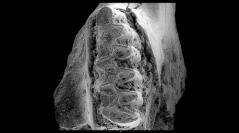

 Comptes Rendus Palevol
15 (6) - Pages 707-719
Comptes Rendus Palevol
15 (6) - Pages 707-719Rodents are among the most useful proxies for reconstructing the ecology and environment of the Quaternary. The present paper focuses on a series of fossil rodent assemblages from northeastern Iberia of the Late Pleistocene (ca. 128–11.7 ka BP) and the beginning of the Holocene (< 11.7 ka BP). Descriptive and multivariate statistical methods have been applied to expand what is known about the species involved and their palaeoecological implications. The results show the importance of the three predominant species: Microtus arvalis, Microtus agrestis and Apodemus sylvaticus. A transition in the ecological conditions is shown in the studied area during the course of this interval: from open environments and cooler climatic conditions to more forested landscapes and temperate conditions. The beginning of the Late Pleistocene and the Holocene share similarities, and both differ clearly from the end of the Late Pleistocene, showing the singular nature of the environmental conditions of Marine Isotope Stage 2 in the northeastern sector of the Iberian Peninsula.
Rodentia, MIS 2, Palaeoenvironment, Middle Palaeolithic, Upper Palaeolithic, Late Glacial Maximum